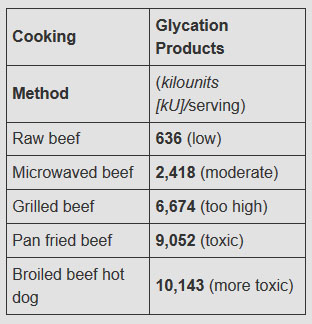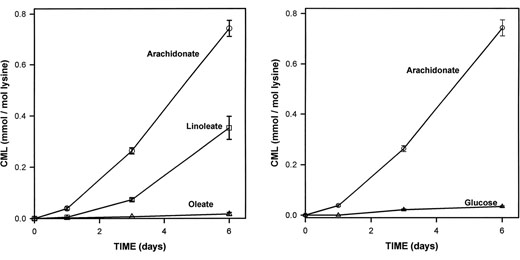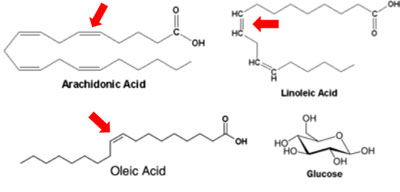 Eating is wonderful. Except when it isn’t. Such as when it exposes you to the monumentally dangerous substances that scientists call advanced glycation end products (AGEs). AGEs speed up aging and underlie many degenerative diseases, including diabetes, atherosclerosis, chronic renal failure, Alzheimer’s disease, high blood pressure, stroke, osteopenia, and generation of epithelial cancers.
Eating is wonderful. Except when it isn’t. Such as when it exposes you to the monumentally dangerous substances that scientists call advanced glycation end products (AGEs). AGEs speed up aging and underlie many degenerative diseases, including diabetes, atherosclerosis, chronic renal failure, Alzheimer’s disease, high blood pressure, stroke, osteopenia, and generation of epithelial cancers.
Unfortunately, scientific jargon about AGEs has kept this all-important topic from becoming a popular subject on social media and at parties, picnics and family gatherings. We clearly need a new term that the public can understand and talk about intelligently.
Since AGEs represent oxidation gone amok, and since oxidation is a burning of sorts, I propose that we refer to AGEs as Burnt Crap in Foods (BCFs). There, isn’t that better? Now let’s delve into BCFs to see what they do, where they are, and how to minimize damage to your health from them.
What are AGEs?
The overview of AGEs here on Wikipedia specifically refers to their formation as the non-enzymatic attachment of carbohydrates to a proteins.
By the way, BCFs entail more than AGEs. They also include advanced lipidoxidation end products (ALEs). ALEs form by the attachment of fats to proteins. Like AGEs, ALEs are a category of BCFs.
Although most research has addressed AGEs much more than ALES, ALEs are estimated to cause four to six times as much oxidative stress as AGEs.
For the purposes of this article, BCFs refer to both of these categories.
Not Included
Charred foods can contain an entirely different type of burnt crap called polycyclic aromatic hydrocarbons (PAHs). These are also super dangerous to health. Read more about PAHs here on Wikipedia if you are curious. I won’t be mentioning them again in this post. Just keep in mind that charring or blackening foods is a dangerous practice for your health.
Because of PAHs, you should never, ever consume charred foods.
Reducing Exposure to BCFs
Three main sources of BCFs increase our exposure to them. External sources include raw foods as well as BCFs generated by cooking. Internal sources entail what our bodies make after we eat something.
BCFs in Raw Foods
A recent review in the Journal of the American Dietetic Association (2010 Jun; 110(6): 911–16.e12; full article here), Advanced Glycation End Products in Foods and a Practical Guide to Their Reduction in the Diet, lists 549 foods surveyed for their BCFs content. The list includes raw and cooked foods. The summary table in the article is available here: Table 1.
One step in avoiding BCFs is to choose foods that have the lowest levels.
SIDENOTE: In the extreme, you can dispense with eating entirely if you know how. The scientific basis behind this claim is substantial. If you are really curious, take a look at this research report on how to live without eating: Bigu State: Can Meditation Trigger Alternate Metabolic Pathways Through Epigenetic Changes?. Just a thought. Personally, I’d rather eat.
Cooking and BCFs
Cooking at high temperatures leads to the formation of BCFs. This table gives you an idea of what can happen when you cook:

Reference at Life Extension Foundation: Live Longer By Changing How You Cook!
The Missing Link from Dr. Oz
Dr. Oz is the leader of the anti-red meat and anti-eggs pack. He merely parrots the party line from the American Heart Association and the majority of mainstream medicine. They are, of course, as wrong as can be. (E.g., see TMAO – Dr. Oz’ Latest Heart Risk Boogeyman in Red Meat)
The main issue with any foods that can cause inflammatory damage – meats, veggies, fruits – is what happens to them during cooking. Without taking this variable into account, all advice on eating a healthy diet is incomplete and misguided.
Modifying Cooking Methods
The most effective way to reduce intake of foods high in BCFs is to modify cooking methods. Research shows that dry heat promotes BCFs formation by more than 10- to 100-fold above uncooked foods in all food categories. Foods cooked with moist heat, shorter cooking times, lower temperatures, and acidic ingredients such as vinegar or lemon juice produce the least amount of BCFs.
If you insist on grilling your food, just do so less often. When you do, use an acidic marinade that contains lemon or other citrus fruit juices, or vinegar.
Keep in mind that browned or charred foods indicate the formation of BCFs.
missing component of nearly all advice on healthy eating.
Your Body Makes BCFs Internally, Too
Reducing your exposure to BCFs must also include those that are made after you eat something.
They are made when dietary fats and sugars combine with protein once they get into your body. This is equivalent to internal browning and charring, although you may not see it. The most obvious manifestation of internal BCFs is skin spots. The old terms for these spots – liver spots or aging spots – actually refer to BCFs that become deposited in your skin.
BCFs in your skin form when dietary sugar combines with collagen and elastin, the main structural proteins in skin. Yup – so-called aging spots are actually a sign of too much sugar in your diet.
Guess what the solution entails? Cut down on eating sugar!
Of course, the formation of skin spots is driven by inflammation – i.e., the ‘burning’ behind the formation of BCFs. Cutting down on sugar is just part of a solution that has to address chronic inflammation, too.
Another source of internal BCFs is unsaturated fatty acids. Polyunsaturated fatty acids (PUFAs) are the biggest culprit. A brief survey comparing the effects of fatty acids and sugar reveals that PUFAs are much more damaging than our main blood sugar, glucose. See the graphs below.


As you can see, arachidonic acid (4 reactive double bonds) leads to the formation of more BCFs than do linoleic acid (2 reactive double bonds) or oleic acid (1 reactive double bond).
If you want to know what foods have the highest amount of arachidonic acid, here is a good overview: What Foods Are High in Arachidonic Acid?
Similarly, linoleic acid occurs as the predominant fatty acid in safflower oil (75%), sunflower oil (66%), hemp oil (60%), corn oil 59%), cotton seed oil (54%), soybean oil (51%), walnut oil (51%) and sesame oil (45%).
Cutting down on these foods, however, is an over-simplified strategy for reducing internal BCFs. Certain fatty acids are essential – the omega-3 and omega-6s – for good health. These include PUFAs such as arachidonic acid and DHA (from fish oils).
Once again, how your body handles fatty acids regarding the formation of BCFs is completely dependent on your chronic inflammation load. If you have any kind of chronic inflammation (e.g., ANY chronic disorder or disease of aging), cutting out essential fatty acids will not help. You have to address the inflammation first.
Neutralizing BCFs
As you can see, even so-called health foods can either be laden with BCFs, form BCFs when cooked, or lead to the formation of BCFs in your own body. Besides skipping eating entirely, what can you do to minimize exposure to these dangerous substances?
Reducing the consumption high-BCF foods, modifying cooking methods, and reducing your inflammatory load are key steps for minimizing BCFs in your body.
Anti-BCF Foods and Supplements
Research on a naturally occurring dipeptide (i.e, two amino acids) called carnosine points to this substance as one of the best anti-aging supplements now available. It works partly by inhibiting glycation that leads to the formation of BCFs. It is also an antioxidant.
Jon Barron at the Baseline of Health Foundation provides details of its history and current usage as an anti-aging supplement, here: Carnosine, Still the Best for Anti-Aging.
A brief summary of the health benefits of carnosine includes the following:
- Increases life expectancy
- Reduces familiar signs of aging such as wrinkling skin, cataracts, and the destruction of our brain and nervous system
- Prevents Alzheimer’s Disease
- Thins the blood of people whose blood tends to clot too much and increases the clotting tendency in those with a low clotting index
- Suppresses excess immune responses in those who have “hyper” immune systems (allergies, autoimmune disorders), whereas it stimulates the immune response in those with weakened immune systems
- Helps to normalize brain wave functions (with invaluable role in helping to prevent and control seizures)
- Helps control blood glucose
- Helps control primary factors in the onset of diabetes, including protection against diabetic echo effects (organ protein degradation, loss of kidney function, damage to the eyes, neuropathy, and cardiovascular damage
- Helps the heart muscle contract more efficiently
- Helps with wound healing
- Protects against the side effects of chemotherapy
- Protects against alcohol induced liver damage
- Reduces inflammation in your brain
In general people who benefit from the health benefits above are suffering in the first place because of low carnosine. Normally carnosine occurs in high levels in brain and muscle.
WHERE DO WE GET CARNOSINE?
Our bodies make it by combining its two component amino acids, beta-alanine and L-histidine. Unfortunately, as with most things as we age, our internal synthesis slows down over time.
We also get it from certain foods. The main sources are meat, especially beef and pork. Chicken has a little, fish even less.
Research on the effective dosages for carnosine show that 1,000 mg a day will provide the benefits shown in research studies. Getting enough from food would require consuming about 7 ounces of steak at least 3 times a day.
Carnosine metabolizes fast once we consume it, usually within a few hours. It therefore has to be replenished 2-3 times a day.
For people who don’t eat enough meat to get 1,000 mg of carnosine daily, convenient supplements are available to make up for it. If you’re in the market for this supplement, look for a product at Vitacost.com here. It’s usually the most cost-effective source.
What About Vegetarians?
Plants do not make carnosine. Vegetarians routinely have deficiencies in this natural ingredient, as much as 50 percent less in their muscle tissue than meat eaters.
All the best,
Dr. D
Hello! Found your blog via your post about veggie caps. Loving it, thus far. So many interesting topics and it is refreshing to not see the same cut-and-paste advice. I am a bit confused about how the body creates BCF’s. Is this from food combining? Say, a chicken breast on salad with a high-PUFA dressing? Would starch and fat (like rice and gravy) be an issue, especially if eaten with a hunk of meat? What about the fat on meat, like a ribeye? This is such an eye-opening article, and right on time, as I am trying to change my diet after putting on some quarantine pounds. I am leaning towards a lower-carb Mediterranean-like diet. I appreciate any info you can provide. Cheers!
Hi, ShivaD: I’m glad you found me. One concept of interest regarding your questions is the diversity of BCFs we are exposed to. Although I focused on dietary sources, the more dangerous ones might be the equivalent of ‘burned crap we make in our bodies’. Yup, we literally burn ourselves up internally. In other words, a common source of AGEs and ALEs is our own bodies. Dietary PUFAs will make these processes worse. The better questions for you are, what do we do that makes this happen and what can we do to prevent it? The key is your redox potential. As one doctor put it succinctly a while back: You could do fine eating shit on a shingle if your redox potential was good. Of course, most people (including the vast majority of doctors) haven’t a clue what that is or what it means for human health. Rather than diving into it here, I’ll just refer you to a starter article to get your thinking going along this path. It’s here: https://jackkruse.com/redox-rx/. Feel free to ask any questions you might have. I’ve adopted a redox-lowering lifestyle over the past 5 years, so I’ve got some experience with it.
All the best,
Dennis